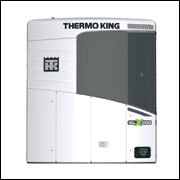 Significant savings are possible by choosing the right equipment and operating methods. With a recent Mintel survey revealing that 41 per cent of consumers believe food retailers should provide more details on the food miles of the products they sell, supermarkets have never been under greater pressure to bolster their environmental credentials. The knock-on effect is being felt in the refrigerated transport market as producers, distributors and retailers seek to respond to their share holders’ and customers’ concerns by minimising the carbon footprint of their operations.
Significant savings are possible by choosing the right equipment and operating methods. With a recent Mintel survey revealing that 41 per cent of consumers believe food retailers should provide more details on the food miles of the products they sell, supermarkets have never been under greater pressure to bolster their environmental credentials. The knock-on effect is being felt in the refrigerated transport market as producers, distributors and retailers seek to respond to their share holders’ and customers’ concerns by minimising the carbon footprint of their operations.
“Over the last few years the food industry has been looking for new ways to cut down the amount of CO2 released into the atmosphere as food is transported,” said Bill Roxby, trailer marketing manager for Thermo King. One of the less obvious sources of CO2 is the refrigeration equipment used in the transport of temperature sensitive foodstuffs. And the leading manufacturer of such equipment, Thermo King, has responded to the challenge by developing a new product range promising substantial reductions in CO2.
“Our research and development team were tasked with producing a new trailer unit which would deliver reduced fuel consumption, and therefore reduced CO2 emissions throughout the lifecycle of the product,” said Roxby.
“With a diesel driven unit, 99 per cent of the greenhouse gas emissions go out through the exhaust, so we looked at ways of minimising emissions while the unit was running to provide the greatest savings.”
The choice of drive system was critical, to avoid unnecessary energy conversion phases and thus avoid efficiency losses. The system chosen was a proven direct drive from engine to compressor and belt drive from engine to air delivery system. Efficiency losses in such a system are less than five per cent compared with losses in the region of 25 per cent in systems using an electrically driven compressor and fans.
Doubling the size of the condenser coil from the predecessor SL range means that the SLX can operate at reduced engine speeds without any loss in performance. This gives a quieter unit which uses significantly less fuel, and therefore emits less CO2. Further savings can be made by the unit’s Cycle Sentry system which stops the engine when refrigeration is not needed.
Bill Roxby added: “We started off by looking at our assembly process in terms of CO2 emissions. By calculating the quantities of each type of fuel used we worked out that 200.2kg of CO2 were emitted per unit during the assembly process.
“Compare this to the savings that can be made during the course of a year – in a typical operation of 2000 engine hours the SLX would deliver over 2000 kg reduction in CO2 emissions when compared with the SL. This saving is ten times more than the total emitted during the assembly process. And it is a saving made every year for the equipment’s life.”
The SLX uses R-404A as a refrigerant – a chlorine free chemical without depleting effects on the ozone layer. Thermo King is aware of R-404A’s potential as a greenhouse gas, and therefore has strict safeguards in place to stop it getting into the atmosphere.
“Every single unit is tested at a molecular level, using helium to detect any leakage potential because helium molecules are smaller – and therefore leak more readily – than refrigerant molecules,” said Roxby. “All Thermo King dealers have facilities to collect and recycle refrigerant under extremely strict conditions.”
Thermo King dealers are also able to provide training and advice to customers on how to minimise fuel consumption and reduce the environmental impact of their operation.
Bill Roxby said: “There are lots of things that customers can do – such as ensuring that they load goods at the correct temperature, use door switches to turn off the refrigeration system automatically when a door is opened and fit door curtains the best of which open and close automatically for convenient loading and unloading. Our dealers are here to make sure customers receive advice when they need it.”
In summary, careful selection of equipment and good operational procedures can go a long way towards substantially reducing a transporters’ carbon footprint. Improved performance in this area is sure to be appreciated by increasingly aware consumers and may well influence their buying decisions.




Comments are closed.